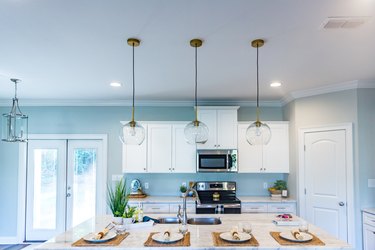
Cabinets are a focal point in a kitchen. A majority of the surface area is covered with cabinetry, and the finish of the cabinets will help to set the overall design of the room. Purchasing unfinished vs. finished cabinets helps to lower costs while giving you full control over the finish of the cabinets. While wood stain helps to reinforce the grain of the wood, a painted finish can disguise cabinets created with a cheap or poor quality wood.
However, even high-quality wooden cabinets will end up looking less-than-stellar if you don't follow proper painting techniques like those described by Fine Homebuilding. For example, it's important to prep the cabinets to ensure the paint adheres to the wood, and allowing the paint to dry completely before adding another layer (or two) will help reduce chipping. Fortunately, this process is DIY-friendly.
Video of the Day
Video of the Day
Prepare the Cabinets for Painting
First, you need to sand the cabinets. Start with a high-grain paper for the tougher sanding, and finish with a low grain. Usually, using three different grains is sufficient, but it depends on how rough the unfinished cabinets are. Follow the grain of the wood when you sand, using sandpaper taped around a block of wood for the flat surfaces. In crevices and dipped surfaces, use sand paper without a block.
Remove the dust from the cabinet after sanding. It is very important to remove the wood dust; otherwise it will get into the paint and create a granular-looking finish. Use a vacuum cleaner to remove a majority of the dust, then wipe with a clean damp cloth to finish removing the remaining dust. Let the cabinets dry completely before proceeding to the next step.
Add a Coat of Primer
Prime the cabinets using a wood primer. If the cabinet is a simple flat surface, use a paint roller to apply the paint. If there are ridges in the cabinet, use a high-quality paint brush, filling in any crevices first, then doing the flat surfaces.
Be sure to apply a thin, even coat of paint and avoid allowing the paint to pool on the cabinet. Allow the primer to dry and set thoroughly, based on the instructions on the paint can: each brand has different drying times.
Choose a Type of Paint for Wood Cabinets
You can use virtually any type of paint for wood cabinets. The most important factor to consider when choosing paint is to find one compatible with the kind of primer you used. For example: if your primer is for acrylic paint, you should use acrylic paint. This type of paint is water based and less toxic than oil-based paints.
Apply the paint using the same method as you did the primer, filling in any crevices first, then continuing with the flat surfaces. Be sure to use full, even brush strokes to create an even paint surface. Apply the first layer and let dry completely before applying a second and final layer of paint.
Let the cabinets dry completely before flipping over to paint the opposite side. Paint the opposite side following the same steps as above.